The AMD Ryzen Threadripper 3960X and 3970X Review: 24 and 32 Cores on 7nm
by Dr. Ian Cutress, Andrei Frumusanu & Gavin Bonshor on November 25, 2019 9:05 AM ESTCPU Performance: Encoding Tests
With the rise of streaming, vlogs, and video content as a whole, encoding and transcoding tests are becoming ever more important. Not only are more home users and gamers needing to convert video files into something more manageable, for streaming or archival purposes, but the servers that manage the output also manage around data and log files with compression and decompression. Our encoding tasks are focused around these important scenarios, with input from the community for the best implementation of real-world testing.
All of our benchmark results can also be found in our benchmark engine, Bench.
Handbrake 1.1.0: Streaming and Archival Video Transcoding
A popular open source tool, Handbrake is the anything-to-anything video conversion software that a number of people use as a reference point. The danger is always on version numbers and optimization, for example the latest versions of the software can take advantage of AVX-512 and OpenCL to accelerate certain types of transcoding and algorithms. The version we use here is a pure CPU play, with common transcoding variations.
We have split Handbrake up into several tests, using a Logitech C920 1080p60 native webcam recording (essentially a streamer recording), and convert them into two types of streaming formats and one for archival. The output settings used are:
- 720p60 at 6000 kbps constant bit rate, fast setting, high profile
- 1080p60 at 3500 kbps constant bit rate, faster setting, main profile
- 1080p60 HEVC at 3500 kbps variable bit rate, fast setting, main profile
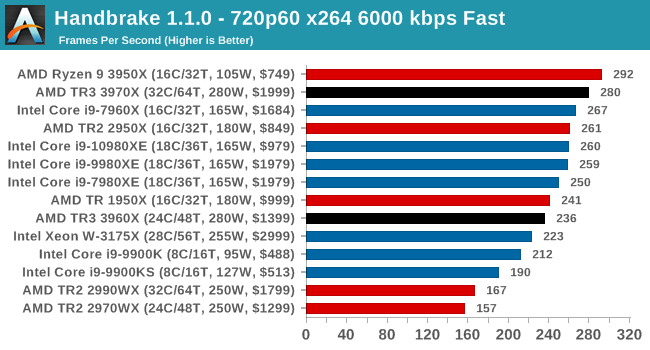
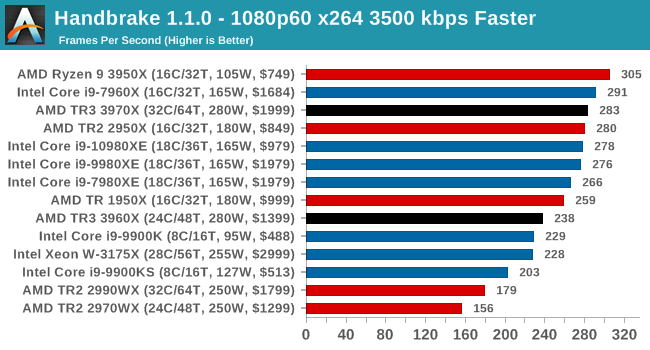

Video encoding is a little varied, based on the variable threaded nature. Certain encoding tests can be more memory sensitive here, or accelerated in different ways, or not scale well with more cores. Either way, TR3 performs a lot better than TR2, but the 3950X seems the best choice.
7-zip v1805: Popular Open-Source Encoding Engine
Out of our compression/decompression tool tests, 7-zip is the most requested and comes with a built-in benchmark. For our test suite, we’ve pulled the latest version of the software and we run the benchmark from the command line, reporting the compression, decompression, and a combined score.
It is noted in this benchmark that the latest multi-die processors have very bi-modal performance between compression and decompression, performing well in one and badly in the other. There are also discussions around how the Windows Scheduler is implementing every thread. As we get more results, it will be interesting to see how this plays out.
Please note, if you plan to share out the Compression graph, please include the Decompression one. Otherwise you’re only presenting half a picture.
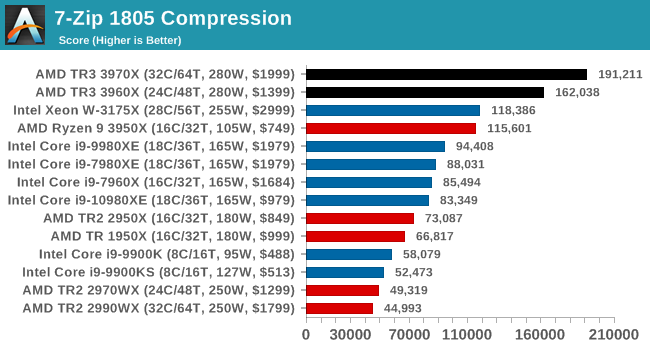
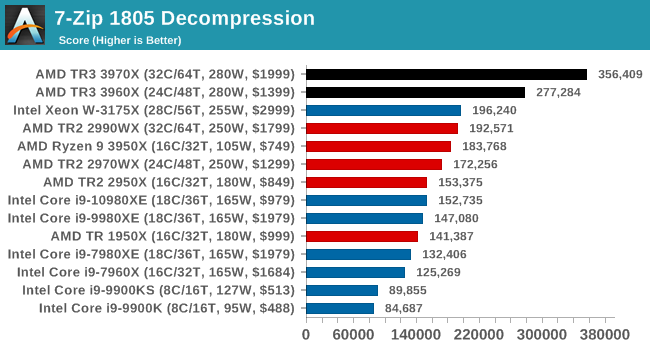
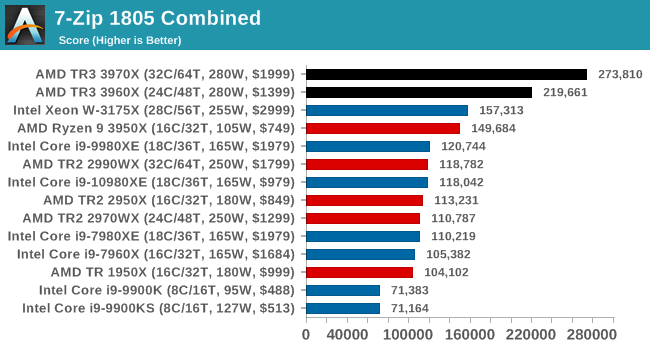
Easily parallel puts the TR3 well ahead of TR2 and Intel.
WinRAR 5.60b3: Archiving Tool
My compression tool of choice is often WinRAR, having been one of the first tools a number of my generation used over two decades ago. The interface has not changed much, although the integration with Windows right click commands is always a plus. It has no in-built test, so we run a compression over a set directory containing over thirty 60-second video files and 2000 small web-based files at a normal compression rate.
WinRAR is variable threaded but also susceptible to caching, so in our test we run it 10 times and take the average of the last five, leaving the test purely for raw CPU compute performance.
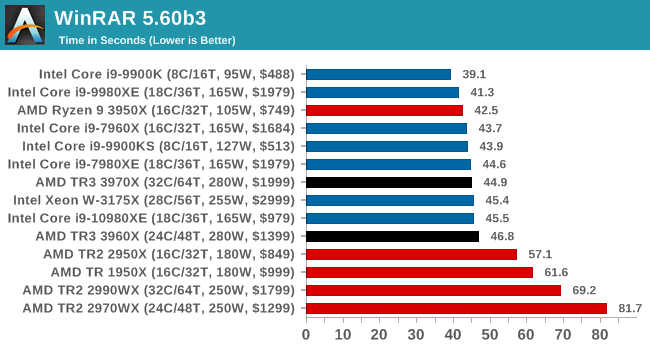
WinRAR is a variably threaded application, and both TR3 processors perform in the same ballpark as anything from Intel. Ideally we should have seen them streak ahead, but we seem to be at a point where CPU frequency or core counts are the limiting factor. At least with Zen 2, there are no issues as there was with Zen 1/Zen+.
AES Encryption: File Security
A number of platforms, particularly mobile devices, are now offering encryption by default with file systems in order to protect the contents. Windows based devices have these options as well, often applied by BitLocker or third-party software. In our AES encryption test, we used the discontinued TrueCrypt for its built-in benchmark, which tests several encryption algorithms directly in memory.
The data we take for this test is the combined AES encrypt/decrypt performance, measured in gigabytes per second. The software does use AES commands for processors that offer hardware selection, however not AVX-512.











245 Comments
View All Comments
Silma - Monday, November 25, 2019 - link
Not.Congrats to AMD on great processors, but the consumer market for $1,4-$2k processors is super tiny.
Despite the current generation of AMD processors for desktops being arguably superior to those of Intel, in the financials, Intel still destroys AMD and it is indeed a bloodbath.
In my opinion, AMD would hurt Intel much more, and in the end earn more money, if it priced its offerings lower, for consumer processors as well as datacenter processors.
sgeocla - Monday, November 25, 2019 - link
Not that small.>> Workstations are a growing market segment and have been for quite some time. They run 24-7, are extremely reliable, and have features and specifications you can’t find in a PC. Therefore, workstations can command high price points because of the high expectations users have for them. Our research shows the market size for workstations is approximately 5.3 million units, about 2% of the total PC market, and brings in over $10 billion dollars a year, almost 2.5% of the PC market total, which indicates the average selling price (ASP) is higher than the ASP of a PC.
https://gfxspeak.com/2019/05/13/stands-for-worksta...
melgross - Monday, November 25, 2019 - link
Very small. The more cores, the smaller the market. What are so many cores good for? Video editing, huge databases. Financial transactions, which the chips are not likely to be used for.For most everyone else, 8 cores is still the sweet spot.
ShowsOn - Monday, November 25, 2019 - link
The review literally discusses this point:"...Intel has reported that the workstation market has a potential $10B a year addressable market, so it is still worth pursuing. While I have no direct quotes or data, I remember being told for several generations that Intel’s best-selling HEDT processors were always the highest core count, highest performance parts that money could buy. These users wanted off-the-shelf hardware, and were willing to pay for it – they just weren’t willing to pay for enterprise features...Now that we can get better performance at $1999 with 32 cores, assuming AMD can keep stock of the hardware, it stands to reason that this market will pick up interest again."
twtech - Monday, November 25, 2019 - link
They need to partner with a workstation vendor such as Dell, HP, etc. - or pick/create a company to partner with. Big businesses like to have a reliable single vendor they can deal with for all their server and workstation hardware, including support.eek2121 - Monday, November 25, 2019 - link
They really need Dell.xrror - Tuesday, November 26, 2019 - link
Sadly Dell always seems anti-AMD - or I guess more accurately they absolutely will not do anything that could jeopardize receiving Intel's contrarevenue.eek2121 - Monday, November 25, 2019 - link
Pretty much anybody that does graphics, video, etc. has a need for these CPUs. A large portion of professional Youtubers use blender or similar applications (that scale perfectly) to render things like 3d animations and the like. On the contrary. The market for these types of CPUs is larger than the gaming market. AMD's biggest obstacle here is getting prebuilt OEM systems built with sufficient cooling. Not many folks in that audience are going to build their own PC.melgross - Monday, November 25, 2019 - link
Nope. Graphics apps don’t use all these cores. I run that stuff. Neither do apps like Photoshop. If sometimes they use most cores, the usage ore core I’d down around 20% in spurts. Fewer cores simply have higher per core usage.As I said, video rendering is about the only thing that most users will find using a lot of cores. Even multasking doesn’t use 16 or more cores efficiently.
It’s also interesting that years ago, the argument was too much power. 150 Watters was considered to be on the high side, and not in a good way. Now these cores are moving to 300 watts, and nobody is saying anything.
Jimbo Jones - Tuesday, November 26, 2019 - link
Video rendering3D rendering
3D animation where physics calculation is need (cloth, particles, etc)
Particle simulations for 3D animation / work / science
Game creation / compiling / baking
Progamming (compiling)
VFX -- after effects, etc
Gaming while rendering out any of the above at the same time
Doing more than one thing at a time (Intel users close all their apps to game, lol)
Gaming while streaming
Youtube content creation (requires video rendering and encoding)
Digital audio workstations
To name a couple ...
I actually read someone on another comment feed defending Intel by saying "CPU's aren't even important these days anyway!" -- the desperation of fanbois to grasp at straws to defend the indefensible is hilarious ... right Mel?